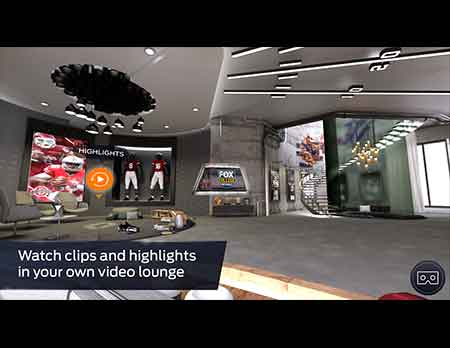Fox Sports Preps Second Live NCAA Football VR Broadcast

Not everything went perfectly for Fox Sports Sept. 17, when it debuted the first-ever live VR treatment of an NCAA football game, broadcasting the match-up between Ohio State and Oklahoma via the Fox Sports VR app. But it went well enough for the network to do it again.
B&C has learned that Fox Sports will give the Oct. 8 Red River Showdown between Oklahoma and Texas in Dallas live VR treatment, with the broadcaster making some minor changes following its first experiment.
“We knew going in that it wasn’t going to be perfect, that we were going to find things that needed to be done better, and that turned out true, but all told the experience, the delivery from [VR platform partner] LiveLike, the artwork in the [virtual] suite, it went as well as it possibly could,” said Mike Davies, senior VP of field and technical operations for Fox Sports Media Group.
Related: 360 Video—Virtual Reality’s Path to the Mainstream
An estimated 37,000 people took advantage of the first, free VR college football broadcast, and aggregate session times were much higher than Fox Sports anticipated, with viewers averaging 12 minutes each. Davies attributed the numbers to the fact that Fox and LiveLike didn’t restrict the VR app to headsets, allowing both iOS and Android device owners to view the VR broadcast as a simple 360-degree experience.
“It’s probably the biggest VR audience out there [to date], because we didn’t require a bunch of special equipment … we didn’t rely on a small subset of people who just had Gear VR goggles,” he said.
Related: Alcatel Debuts VR Device, Camera
Broadcasting & Cable Newsletter
The smarter way to stay on top of broadcasting and cable industry. Sign up below
Still, Fox Sports is taking feedback from viewers, and incorporating their ideas into future live VR sports endeavors. That includes enhancing the features seen in the control panel VR viewers see, adding more live stats, and eventually including viewer-controlled replay features.
Fox Sports is also taking a second look at where it places cameras for the VR broadcast. Goalpost, red zone and sideline cameras will remain, but the network is considering adding cameras on sideline carts as well, but only if the motion of the carts doesn’t interfere with the experience. And the first VR go-around taught Fox Sports that when VR promises to put you on the field, it delivers, even if that’s not the best way to watch a game, Davies added.
Related: IBC—Fox Sports Australia Looks to Aspera
“Football in general is something we can work on in terms of camera positions,” he said. “While it was interesting to get that high wide shot for tactical purposes, and we had two cameras in the red zone, if you’re thinking about a VR experience, sidelines may not be the best way to see a game, but with [VR] that’s exactly what you see. When a running back runs down the sidelines, it is really cool to turn your head and actually follow him, and see everyone else doing the same thing.
“We still have work to do in terms of camera positions for football, and there are some we’d like to try out, but we need to test them.”
Related: Fox Sports Going VR With Bundesliga Opener
The technical challenges are surprisingly minor, with live VR having a small technical footprint: for the Ohio State vs. Oklahoma game, the VR equipment took up just a small part of one trailer, and the cameras themselves needed no operators, and only needed pre-planned positioning. All it took for Fox Sports to give the green light to live VR treatment for the Oct. 8 game was making sure the 86-year-old Cotton Bowl had sufficient bandwidth to handle a live VR stream.
“You try something out, see a full game, get the feedback from the audience, and then see what you want to do next,” Davies said. “Now that we’ve got the first one under our belt, we can start pushing forward.”
